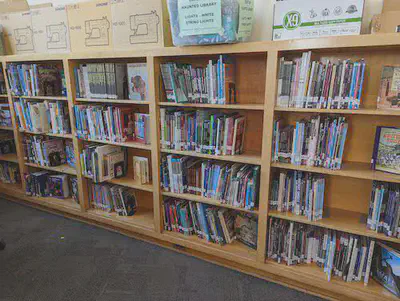Weekly Reflection 5

This week (April 29) was primarily focused on similar tasks to my second week at Eckstein. I ended up covering over a dozen picture books and a few hardbacks with protective plastic, changed dozens of call numbers for the non-fiction section, and rearranged two sections of the library to provide more space and be more functional for students.
The first two (covering books and changing call numbers) simply involved time. I had been taught how to cover books my second week there, which meant that I was able to fill in spare time with this task, which ended up taking a couple hours over the course of the school day. Changing call numbers was another filler task, though once numbers were changed in the system and books re-checked-in (some were incorrectly marked as lost and often actually had fines attached to a student’s account through no fault of their own), they needed to be re-shelved in their new location in the non-fiction section.

Through both mine and Erin’s efforts, the non-fiction section is almost entirely weeded as of this point, which means that the next major task is changing call numbers and re-classifying books to be in more logical sections for students. This means playing around with Dewey and strategically breaking it to better serve students.


For example, since we are located in Washington state, and it is unlikely that we will need the Dewey numbers for other states, the American history section is now arranged by time period, with Indigenous histories first in line, acknowledging their histories to time immemorial, and then, after modern history, uses the strategically broken Dewey numbers to indicate granularity of local history – Pacific Northwest, then Washington State, then Seattle. Other sections are effectively “genrefied” despite being non-fiction, with topics such as all types of ancient history being grouped together and infectious diseases and biology being together, along with fashion in the art section, rather than being spread out among different sections based on their exact take on the topic. While this would likely be less useful in a higher academic institution, it works well for browsing at the middle-school level, where most students simply come in to ask for books and find what they need for a school project rather than looking at the catalog.

The other section that I rearranged was the readers lounge picture books. This section was crowded into just two shelves, which was too small for the collection and did not allow for effective browsing. Instead, the sports books were condensed to fewer shelves and the picture books were given some of the then-empty shelves. I found the reasoning behind the reader’s lounge books really interesting and something I had not considered before. The reader’s lounge books are of an easier reading level – closer to elementary school or emerging-reader level – specifically for ESL or special-needs students who want books that they can read more easily without looking like they’re reading little kid books. It also allows for readers who can read fluently but just want to read something fun to have access to an easier level of book. I thought this was a really inclusive and good way of having a wider range of reading levels available in the library without calling out lower reading levels specifically.

Overall, I really learned a lot this week about how Dewey can be broken to better serve library patrons, and about arranging books to be more logical in their order for the students. If this was the only thing that I learned in the entire DFW (and it’s not going to be!) I think I would come away a better librarian for having experienced and helped out during this single week.